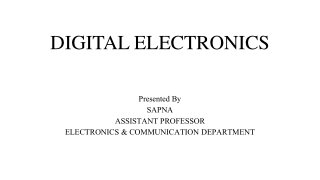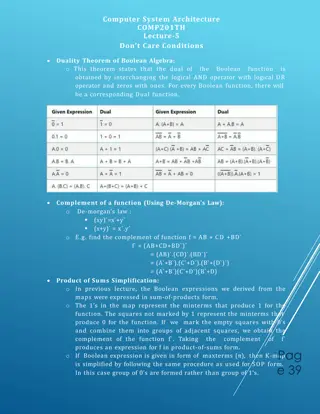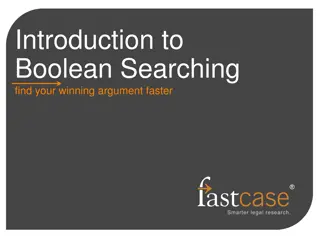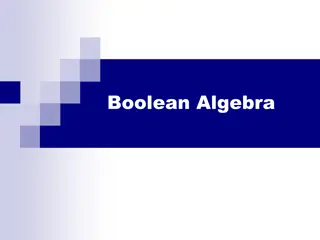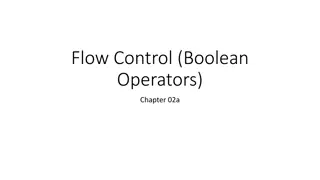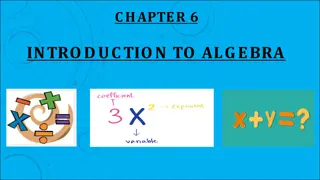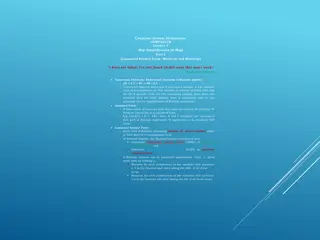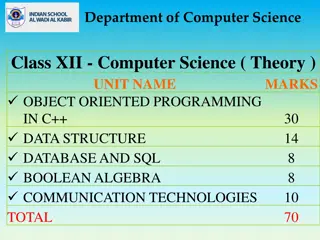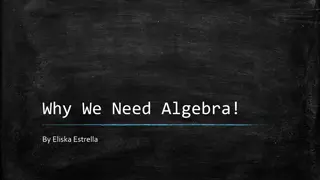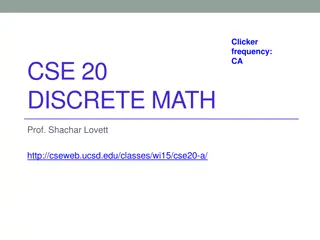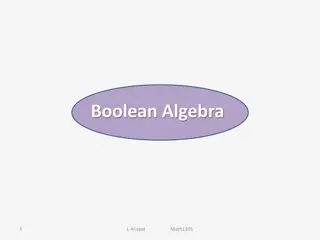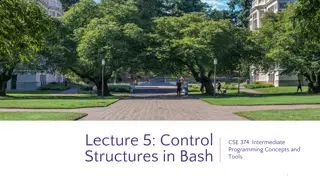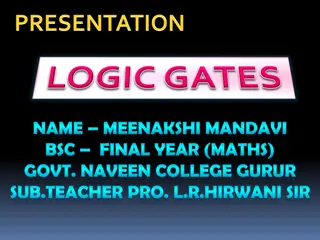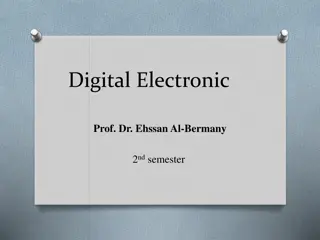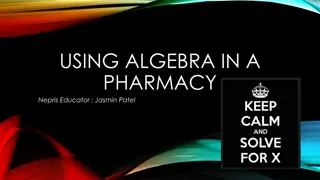Understanding Boolean Algebra in Computer Science
Boolean algebra, developed by mathematician George Boole, is essential in computer systems for performing logical operations with True and False values represented as 1 and 0. It involves operators like AND, OR, and NOT, enabling digital computers to process information effectively. Truth tables aid in visualizing outcomes, and terms like tautology and fallacy describe the validity of expressions. Explore the significance and application of Boolean algebra in the realm of computer science.
Download Presentation

Please find below an Image/Link to download the presentation.
The content on the website is provided AS IS for your information and personal use only. It may not be sold, licensed, or shared on other websites without obtaining consent from the author. Download presentation by click this link. If you encounter any issues during the download, it is possible that the publisher has removed the file from their server.
E N D
Presentation Transcript
XI Computer Science (083) Board : CBSE Unit 1 Computer Systems and Organisation (CSO) CHAPTER 03 BOOLEAN ALGEBRA
INTRODUCTION Developed by English Mathematician George Boole in between 1815 - 1864. It is described as an algebra of logic or an algebra of two values i.e True or False. The term logic means a statement having binary decisions i.e True/Yes or False/No.
APPLICATION OF BOOLEAN ALGEBRA It is used to perform the logical operations in digital computer. In digital computer True represent by 1 (high volt) and False represent by 0 (low volt) Logical operations are performed by logical operators. The fundamental logical operators are: 1. AND (conjunction) 2. OR (disjunction) 3. NOT (negation/complement)
AND operator It performs logical multiplication and denoted by (.) dot. X Y X.Y 0 0 0 1 1 0 1 1 0 0 0 1
OR operator It performs logical addition and denoted by (+) plus. X Y X+Y 0 0 0 0 1 1 1 0 1 1 1 1
NOT operator denoted by (-) bar. It operates on single variable. X X (means complement of x) 0 1 1 0 It performs logical negation and
Truth Table Truth table is a table that contains all possible values variables/statements in a Boolean expression. of logical No. of possible combination = 2n, where n=number of variables used in a Boolean expression.
Truth Table The truth table for XY + Z is as follows: Dec X Y 0 0 0 1 0 0 2 0 1 3 0 1 4 1 0 5 1 0 6 1 1 7 1 1 Z 0 1 0 1 0 1 0 1 XY 0 0 0 0 0 0 1 1 XY+Z 0 1 0 1 0 1 1 1
Tautology & Fallacy expression is always True or 1 is called Tautology. If the output of Boolean If the output of Boolean expression is always False or 0 is called Fallacy.
Exercise 1. Evaluate the following Boolean expression using Truth Table. (a) X Y +X Y (c) XY (Z+YZ )+Z (b) X YZ +XY 2. Verify that P+(PQ) is a Tautology. 3. Verify that (X+Y) =X Y
Implementation computers electronic circuits. These circuits perform Boolean operations and these are called logic circuits or logic gates. Boolean Algebra applied in
Logic Gate operates on one or more signals and produce single output. Gates are digital circuits because the input and output signals are denoted by either 1(high voltage) or 0(low voltage). There are three basic gates and are: 1. AND gate A gate is an digital circuit which 2. OR gate 3. NOT gate
AND gate The AND gate is an electronic circuit that gives a high output (1) only if all its inputs are high. AND gate takes two or more input signals and produce only one output signal. Input A 0 0 1 1 Input B 0 1 0 1 Output AB 0 0 0 1
OR gate The OR gate is an electronic circuit that gives a high output (1) if one or more of its inputs are high. OR gate also takes two or more input signals and produce only one output signal. Input A 0 0 1 1 Input B 0 1 0 1 Output A+B 0 1 1 1
NOT gate The NOT gate is an electronic circuit that gives a high output (1) if its input is low . NOT gate takes only one input signal and produce only one output signal. The output of NOT gate is complement of its input. It is also called inverter. Input A Output A 0 1 1 0
PRACTICAL APPLICATIONS OF LOGIC GATES AND Gate So while going out of the house you set the "Alarm Switch" and if the burglar enters he will set the "Person switch", and tada the alarm will ring.
PRACTICAL APPLICATIONS OF LOGIC GATES AND Gate Electronic door will only open if it detects a person and the switch is set to unlocked. Microwave will only start if the start button is pressed and the door close switch is closed.
PRACTICAL APPLICATIONS OF LOGIC GATES OR Gate You would of course want your doorbell to ring when someone presses either the front door switch or the back door switch..(nice)
PRACTICAL APPLICATIONS OF LOGIC GATES NOT Gate When the temperature falls below 20c the Not gate will set on the central heating system (cool huh).
NAND Gate Known as a universal gate because ANY digital circuit can be implemented with NAND gates alone.
NAND Gate NAND X Y Z 0 0 1 0 1 1 1 0 1 1 1 0 X Z Y Z = ~(X & Y) nand(Z,X,Y)
NAND Gate F = X F = (X X) = X +X = X X X X Y X Y F X Y F = ((X Y) ) = (X +Y ) = X Y = X Y X X F = X+Y F = (X Y ) = X +Y = X+Y Y Y
NOR Gate NOR X Y Z 0 0 1 0 1 0 1 0 0 1 1 0 X Y Z Z = ~(X | Y) nor(Z,X,Y)
Exclusive-OR Gate XOR X Y Z 0 0 0 0 1 1 1 0 1 1 1 0 X Y Z = X ^ Y xor(Z,X,Y) Z
Exclusive-NOR Gate XNOR X Y Z 0 0 1 0 1 0 1 0 0 1 1 1 X Y Z = ~(X ^ Y) Z = X ~^ Y xnor(Z,X,Y) Z
Basic Theorem of Boolean Algebra T1 : Properties of 0 (a) 0 + A = A (b) 0 A = 0 T2 : Properties of 1 (a) 1 + A = 1 (b) 1 A = A
Basic Theorem of Boolean Algebra T3 : Commutative Law (a) A + B = B + A (b) A B = B A T4 : Associate Law (a) (A + B) + C = A + (B + C) (b) (A B) C = A (B C) T5 : Distributive Law (a) A (B + C) = A B + A C (b) A + (B C) = (A + B) (A + C) (c) A+A B = A+B
Basic Theorem of Boolean Algebra T6 : Indempotence (Identity ) Law (a) A + A = A (b) A A = A T7 : Absorption (Redundance) Law (a) A + A B = A (b) A (A + B) = A
Basic Theorem of Boolean Algebra T8 : Complementary Law (a) X+X =1 (b) X.X =0 T9 : Involution (a) x = x T10 : De Morgan's Theorem (a) (X+Y) =X .Y (b) (X.Y) =X +Y
De Morgan's Theorem 1 Theorem 1 A . B = A + B
De Morgan's Theorem 1 Theorem 1 A . B = A + B
De Morgan's Theorem 1 Theorem 1 A . B = A + B
De Morgan's Theorem 2 Theorem 1 A + B = A . B
De Morgan's Theorem 2 Theorem 2 A + B = A . B
De Morgan's Theorem 2 Theorem 2 A + B = A . B
De Morgan's Theorem 2 Theorem 2 A + B = A . B


